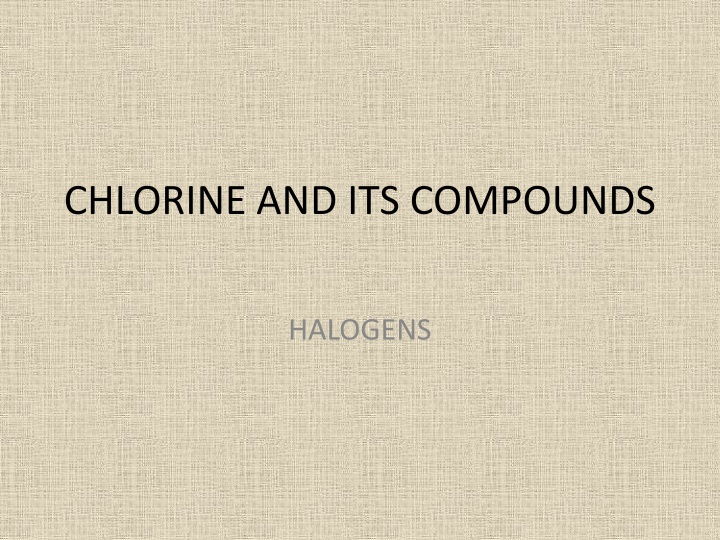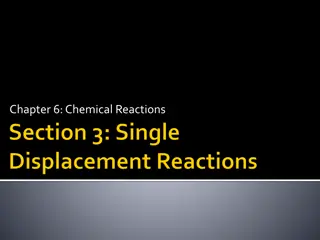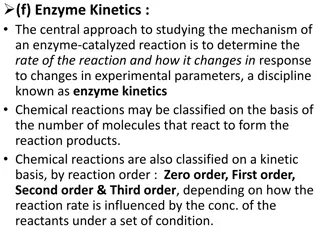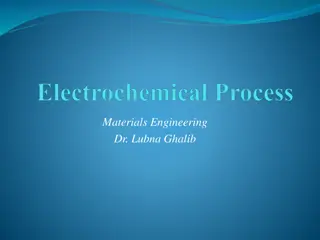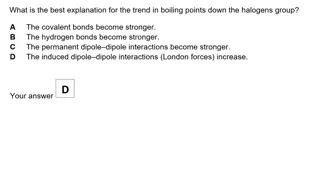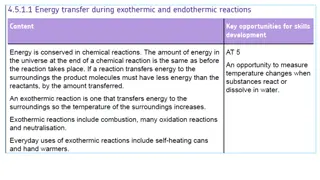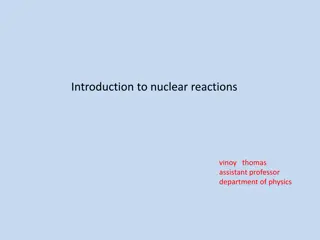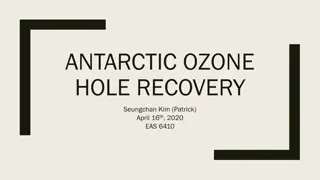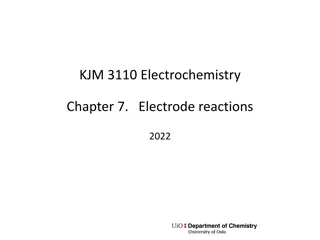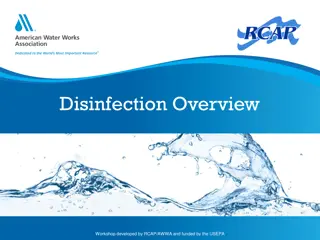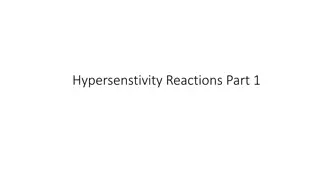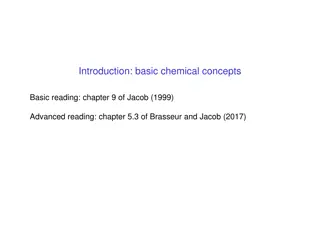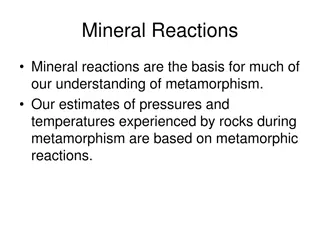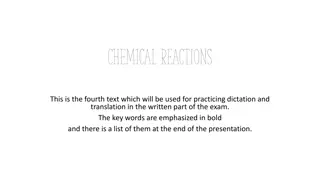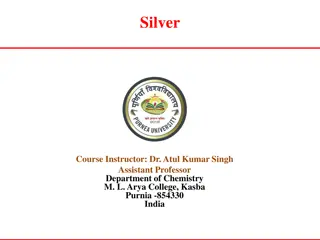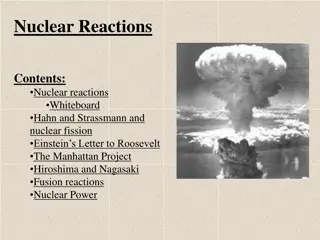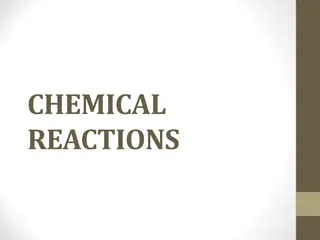Chlorine and Halogens: Properties, Reactions, and Industrial Uses
Halogens, including chlorine, are in group 7 of the periodic table and have 7 electrons in their outer shell. They easily form negative ions by gaining an electron. Chlorine is symbolized as Cl and has two isotopes, 37Cl and 35Cl, with an electronic arrangement of 2:8:7. It can be prepared in the laboratory by oxidizing hydrogen chloride. Industrially, chlorine is manufactured as a by-product in the production of Caustic Soda through the electrolysis of brine. The process involves a membrane cell with a titanium anode and nickel cathode to prevent unwanted reactions between the products.
Download Presentation

Please find below an Image/Link to download the presentation.
The content on the website is provided AS IS for your information and personal use only. It may not be sold, licensed, or shared on other websites without obtaining consent from the author.If you encounter any issues during the download, it is possible that the publisher has removed the file from their server.
You are allowed to download the files provided on this website for personal or commercial use, subject to the condition that they are used lawfully. All files are the property of their respective owners.
The content on the website is provided AS IS for your information and personal use only. It may not be sold, licensed, or shared on other websites without obtaining consent from the author.
E N D
Presentation Transcript
CHLORINE AND ITS COMPOUNDS HALOGENS
Halogens are in group 7 of the periodic table, on the right. 7 H He Li Be B C N O F F Ne Na Mg Al Si P S Cl Cl Ar K Ca Sc Ti V Cr Mn Fe Co Ni Cu Zn Ga Ge As Se Br Br Kr Rb Sr Y Zr Nb Mo Tc Ru Rh Pd Ag Cd In Sn Sb Te I I Xe Cs Ba La Hf Ta W Re Os Ir Pt Au Hg Tl Pb Bi Po At At Rn Fr Ra Ac Rf Db Sg Bh Hs Mt Ds Rg ? ? ? ? ? ? ?
All halogens have 7 electrons in their outer shell. Electron structure This means that: fluorine 2,7 They can easily obtain a full outer shell by gaining 1 electron. chlorine 2,8,7 They all gain an electron in reactions to form negative ions with a -1 charge. They have similar chemical properties. bromine 2,8,8,7
Chlorine has a symbol 35.5 Cl because it is made up of two isotopes 37 Cl and 35 Cl. It has an electronic arrangement of 2:8:7, hence justifying its position in group (VII). Laboratory preparation Laboratory preparation In order to convert hydrogen chloride to chlorine, it is necessary to remove hydrogen. Removal of hydrogen is oxidation. A powerful oxidizing agent such as manganese (IV) oxide converts hydrogen chloride (HCl) to chlorine (Cl2) The most common laboratory method for preparation of Chlorine is to heat of Manganese Dioxide with concentrated Hydrochloric Acid.
The gas is bubbled through water to remove any traces of hydrochloric gas that may be present and then it is dried by bubbling it through concentrated sulphuric acid. Chlorine may also be prepared by dropping cold concentrated Hydrochloric Acid on crystals of Potassium Permanganate.
MANUFACTURE MANUFACTURE OF OF CHLORINE CHLORINE Chlorine is manufactured industrially as a by-product in the manufacture of Caustic Soda by the electrolysis of brine.
The membrane cell has titanium anode and a nickel cathode. Titanium is chosen because it is not attacked by chlorine. The anode and the cathode compartments are separated by an ion exchange membrane. The membrane is selective; it allows Na+ ions, H+ and OH- ions to flow but not Cl- ions. These ions cannot flow backwards, so products are kept separate and cannot react with each other. At anode, the Cl- ions are discharged more readily than OH- ions because they are in higher concentration and are hence preferred.
A pale green gas is seen coming off at the anode At cathode, it is the H+ ions that accept electrons, as sodium is more reactive than hydrogen Bubbles of hydrogen are seen at the cathode The remaining ions of Na+ and OH- join up and come off as sodium hydroxide, NaOH.
Products and uses Product Product Chlorine Chlorine Uses Uses Poisonous greenish yellow Poisonous greenish yellow gas Used for making; PVC, solvents for dry cleaning, paints and dye stuffs, bleaches, weed killers, pesticides, killing bacteria in swimming pools and in domestic water treatment. Hydrogen Hydrogen Colourless flammable gas Used for making: Margarine, nylon, hydrochloric acid Margarine, nylon, hydrochloric acid Sodium hydroxide Sodium hydroxide Alkaline and corrosive substance Used for making; Soap, detergents textiles, textiles and paper. Soap, detergents,
Test for Chlorine (Cl2) Observations :Chlorine turns damp blue litmus paper red, then white. Conclusion : Chlorine gas is acidic and a bleach.
Properties of chlorine Properties of chlorine (2) Is green-yellow in colour. (3) Has a pungent choking smell and is poisonous. It is twice as dense as air. (4) Will put out a lit splint.
Reactions Reactions 1. Chlorine is a highly reactive element, and undergoes reaction with a wide variety of other elements and compounds. 2. Chlorine is a good bleaching agent, due to its oxidising properties. 3. Chlorine is soluble in water (which solution is called Chlorine Water) and this loses its yellow colour on standing in sunlight, due to the formation of a mixture of Hypochlorous Acid and Hydrochloric Acid.
4.Chlorine gas supports the vigorous combustion of many elements to form their chlorides. For example, Sulphur and Phosphorus burn in the gas.
Bleaching Action If chlorine is passed through water, it forms two acids, hydrochloric acid. Hypochlorous acid (the second acid) is the source of oxygen and is responsible for the bleaching of chlorine. It is important to wash bleached clothes thoroughly to remove hydrochloric acid formed after the process.
Reaction of Chlorine with Hydrogen A mixture of Chlorine and Hydrogen explodes when exposed to sunlight to give Hydrogen Chloride. In the dark, no reaction occurs, so activation of the reaction by light energy is required. Hydrogen and chlorine gas also combine directly in presence of sunlight. A jar of hydrogen is inverted and placed on a jar containing chlorine in the sun. Soon hydrogen chloride is formed
In diffused sunlight, the reaction slows down, and in the dark it is very slow. Hydrogen chloride is highly soluble in water. It dissolves to form hydrochloric acid. This reaction can be used to produce hydrochloric when the hydrogen chloride gas produced is dissolved in water as shown.
2. Reaction of Chlorine with Non 2. Reaction of Chlorine with Non- -Metals Chlorine combines directly with most non-metals (except with Nitrogen, Oxygen and Carbon, C). 3. Reaction of Chlorine with Metals 3. Reaction of Chlorine with Metals Thin foils of metals like sodium, copper, etc. when plunged into a jar of chlorine gas catch fire spontaneously to form their respective chlorides. Metals
With yellow phosphorous Yellow phosphorus first melts and then catches fire spontaneously when introduced into a jar of chlorine gas. It forms thick white fumes of phosphorus (III) chloride and phosphorus (V) chloride
Reaction with hydrogen sulphide On passing chlorine and hydrogen sulphide through separate vents in a upright combustion tube hydrogen sulphide gets oxidised to hydrogen chloride and sulphur. Hydrogen chloride comes out through the middle tube.
Displacement of the Halogens by Chlorine Displacement of the Halogens by Chlorine Halogens are the most electronegative elements. Fluorine is the most electronegative, followed by chlorine then bromine and then iodine. The relative reactivity of the halogens, as described in group trends, can be shown by displacement reactions. These are similar to the metal displacement reactions. For example, Bromine gas bubbled through a solution of potassium iodide in water will displace (take the place of) the less reactive iodine, forming iodine and potassium bromide.
Oxidizing Reaction of Chlorine Chlorine is a strong oxidising agent. Chlorine oxidises Iron (II) Chloride, FeCl2, to the salt containing Iron in the higher oxidation state Iron (III) Chloride, FeCl3. This is possible because Iron has a variable valency.
With alkalis Alkalis, at different temperatures and at different levels of concentration, behave differently with chlorine. (i) With cold dilute alkalis Chlorine reacts with cold dilute alkalis to form their respective chlorides, hypochlorites and water.
(ii) With hot concentrated alkalis Chlorine reacts with hot concentrated alkalis to form their respective chlorides, chlorates and water.
Uses Of Chlorine For the manufacture of bleaching powder and liquid bleaches, To bleach fabrics (e.g. linen and cotton), wood pulp and paper, For the direct manufacture of Hydrochloric Acid by the direct combination of its elements, In the manufacture Sodium Hypochlorite (i.e. domestic bleach), disinfectants, insecticides, plastics and Hydrochloric Acid, As a disinfectant used to kill bacteria in the preparation of drinking water. Chlorine is also important in the manufacture of paints, aerosol propellants and plastics. Also used to make some explosives, poison gases and pesticides.
HYDROGEN CHLORIDE Hydrogen chloride is an hydrogen compound of Chlorine. Chlorine is a highly reactive element and is mainly found in combined state. Its most important source is sodium chloride which is mainly found in large underground deposits, sea and lake such as lake Magadi. Sodium chloride is the main source of chlorine which is used to make hydrogen chloride.
Preparation of hydrogen chloride Hydrogen Chloride may be prepared in the laboratory by heating Concentrated Sulphuric Acid, with Sodium Chloride.
PROPERTIES OF HYDROGEN CHLORIDE Hydrogen chloride is a colourless fuming gas. The polar covalent gas Hydrogen Chloride is very soluble in Water. In aqueous solution, the molecule exists in ionic form, as the positively charged Hydrogen Ion, H+, and the negatively charged Chloride Ion, Cl-. Its solution in water turns blue litmus paper red. Hydrogen chloride has no effect on dry litmus paper as no ions are present in dry gas. The gas hydrogen chloride is made up of covalently bonded molecules. If the gas is dissolved in an organic solvent, such as methylbenzene, it does not show any of the properties of an acid.
For example, it does not conduct electricity or turn a piece of blue litmus paper red. However, when the gas is dissolved in water, a strongly acidic solution is produced. The acidic oxides of sulphur, phosphorus and carbon are the similar. They are covalent molecules when pure, but show acidic properties only when dissolved in water.
